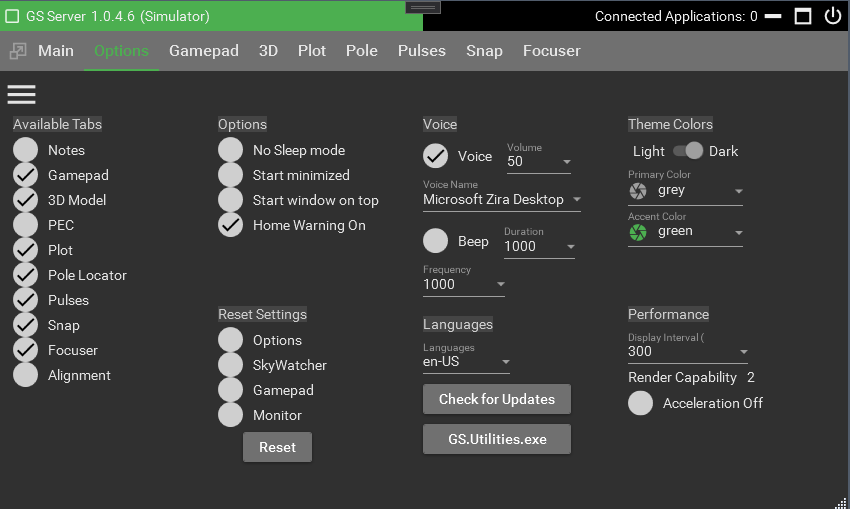
Available Tabs – Turns off or on selected tabs at top of the window. You cannot turn off the Settings tab it will always be available. It’s recommended to set what tabs you want before connected to any hardware. If you have a gamepad the tab must be turned on to activate.
No Sleep mode – When GS server is running it will move the mouse a few pixels every 50 seconds to keep the windows screen saver from starting. This may also help to keep USB ports from going into sleep mode.
Start Minimized – When GS server is started it will show only in the windows taskbar in a minimized state. Click the GS Server icon in the taskbar to open the window to normal state.
Start Window On Top – When GS Server is started the window will be forced to show and stay on top of all other windows.
Home Warning On – When checked a popup warning will show that asks the user to put the mount in the home position. Uncheck this to stop showing the warning.
Voice/Speech on – Turns on/off the selected Microsoft synthesized voice. Windows loaded voices will be shown in the selection box. Refer to Microsoft for loading or unload voices into Windows operating systems.
Theme Colors – Choose light or dark themes along with the Primary and Accent colors.
Performance – This controls how often the driver polls the mount for position information. The faster the polling the more CPU utilization is needed. Unless there is a specific issue it’s recommended to leave at the default 300.
Render Capability – This show the capabilities as defined from Microsoft of your graphics card. This is important for the 3D model. If this number shows below 2 you may have problems showing the 3D graphics.
Acceleration Off – Turns of the graphics card acceleration.
Reset Settings – Rests the selected settings back to their default settings. Each checkbox goes to a set of option and matches the menu items. i.e. if you select SkyWatcher and click reset it will set all the settings under the Main menu back to their default settings. The default setting will take effect the next time GS server is started. It’s recommend after you reset any setting to restart GS server.
Language – Sets the culture. If interested in creating a specific Language file. There are 3 English versions is available in the C:\Program Files (x86)\Common Files\ASCOM\Telescope\GSServer\LanguageFiles; GSServer_en-US.xaml, GSChart_en-US.xaml, and GSUtil_en-US.xaml. Each file goes to the corresponding .exe file in the install folder. These files can be edited with any language, rename the filenames with the correct culture name and submit to the groups.io site to be included in a future release.
Check for Updates – Looks up over the internet for the latest release version. Shows the current or local version and the latest version available for download. When downloaded will open a browser window and attempt to download the latest version.

Monitor – The Monitor is internal logging for GSS by Device, Category, and Type. When the monitor is started it will not quit until turned off, even is the GS server is exited and started again. All files logged are kept in My Documents/GSServer.
Session Log – When checked turns on the log and keeps the last 5 rolling sessions logs.
Log to File – When checked anything shown in the monitor will output to a log file.
Log files are in “My Documents\GSServer”. There are 5 types of logs; Session, Error, Pulses, Monitor, and .err files. Any logs older than 7 days are automatically removed when GS starts. Session, Error, and Pulses are started by default while Monitor is created manually using the Monitor screen. All log entries are created by the Monitor so they are also available using the Monitor screen.
Session log – Shows user actions taken along with any warnings issued by GS.
Format: GSSessionLogyyyy-dd-MM-HH.txt {record Number}, {yyyy:dd:MM:HH:mm:ss.fff}, {Device}, {Category}, {Type}, {Thread}, {Method}, {Message}
Error log – Internal errors issued by GS.
Format: GSErrorLogyyyy-dd-MM-HH.txt {record Number}, {yyyy:dd:MM:HH:mm:ss.fff}, {Device}, {Category}, {Type}, {Thread}, {Method}, {Message}
Monitor log – Items created from the Monitor screen.
Format: GSMonitorLogyyyy-dd-MM-HH.txt {record Number}, {yyyy:dd:MM:HH:mm:ss.fff}, {Device}, {Category}, {Type}, {Thread}, {Method}, {Message} Pulses log – Items created from the Pulses screen. Format: GSPulsesLogyyyy-dd-MM}.txt
.err files – External windows errors that affect GSS. These files may be created as the result of a GSS crash from external sources like Windows.
